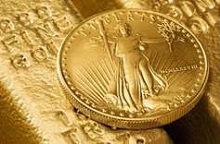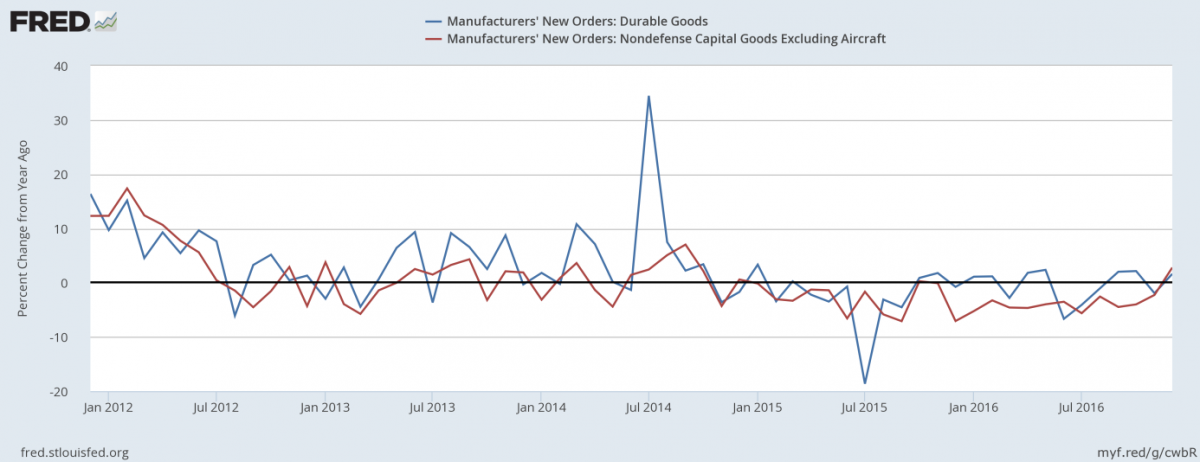Gold Price Modestly Higher On Weak GDP

Last week, several US economic reports were released. What do they imply for the gold market?
GDP Growth Slows
Let’s start with the advance estimate of GDP growth for the fourth quarter. According to the Bureau of Economic Analysis, the economy slowed to 1.9 percent growth from a 3.5 percent jump in the third quarter, as one can see in the chart below.
Chart 1: US real GDP growth from preceding quarter over the last 10 years.
The pace of economic expansion was below the expectations of 2.2 percent. For the full year, the U.S. economy increased just 1.6 percent, a slowdown from the 2.6 percent in 2015. The weak fourth quarter is hardly surprising, as the deceleration resulted from a wider trade deficit. As a reminder, economic growth in the third quarter was artificially boosted by the strong soybean export. What is really disappointing is that the GDP increased mainly due to a build in inventories, which added 1 percentage point to growth. The pace of expansion of personal consumption expenditures slowed down, but gross private domestic investments accelerated significantly.
Initially, the price of gold declined after the report was published, but managed to rebound later and even closed a day with a small gain. However, there are signs that economic growth may accelerate in 2017, which is more important than data on 2016.
Durable Goods Orders Also Fall, But Details Are Positive
New orders for durable goods declined 0.4 percent in December. It was much below expectations, but marked an improvement when compared to a 4.8-percent plunge in November. However, the decrease resulted from a 64-percent downswing in defense aircraft. Core orders, which exclude defense and aircraft capital goods, rose 0.8 percent. The increase may be a good sign for 2017 after an awful 2016, as the chart below shows.
Chart 2: Annual growth of new orders for durable goods (blue line) and core orders (red line) over the last five years.
Other Economic Data
Other U.S. economic data was rather positive. The consumer sentiment measured by the University of Michigan’s Survey of Consumers rose 0.3 points to 98.5, the highest level since January 2004. It seems the consumers, just as investors, believed in Trump’s political promises to accelerate growth.
The Conference Board’s leading economic index rose 0.5 percent in December, following a 0.1 percent increase in November. It signals that the U.S. economy will continue its economic growth at a moderate pace, or even accelerating slightly.
The January Manufacturing PMI rose to 55.1 from 54.3 in December, marking a solid start to 2017. It signals an uptick in U.S. manufacturing activity. Industrial production also increased. According to the Fed, it climbed 0.8 percent last month, reversing the 0.7-percent decline in November. The Philly Fed Index jumped to 23.6 percent in January from 19.7 in December, the highest level since the end of 2014. Similarly, the service sector also accelerated, expanding at the fastest pace since November 2015. The January Service PMI increased to 55.1 from 53.9 last month.
The only dark point may be housing, since new-home sales plunged more than 10 percent in December to a 10-month low, existing-home sales decreased 2.8 percent last month, while the January home-builder confidence index slipped 2 points to 67 after surging to an 11-year high in the aftermath of the presidential election. However, housing starts soared 11.3 percent in December.
Conclusion
The key takeaway is that GDP growth slowed down in the fourth quarter of the 2016. However, it is the past, while investors are forward-looking. And the recent U.S. economic data (especially the data on manufacturing and business investments) signals that the economy may finally accelerate in 2017. This is bad news for the yellow metal, as it implies a more hawkish Fed. Markets are now expecting an interest rate hike not earlier than in June – but the U.S. central bank could want to raise it earlier. Next week may be crucial for the gold market as far as the near future is concerned, as there is a December report on personal income and outlays, January report on employment situation, and the FOMC meeting – stay tuned!
Disclaimer: Please note that the aim of the above analysis is to discuss the likely long-term impact of the featured phenomenon on the price of gold and this analysis does not indicate (nor does it aim to do so) whether gold is likely to move higher or lower in the short- or medium term. In order to determine the latter, many additional factors need to be considered (i.e. sentiment, chart patterns, cycles, indicators, ratios, self-similar patterns and more) and we are taking them into account (and discussing the short- and medium-term outlook) in our trading alerts.




















